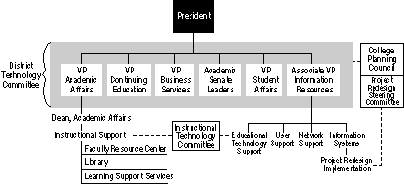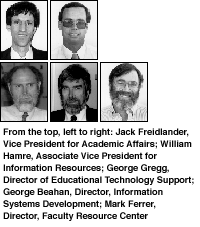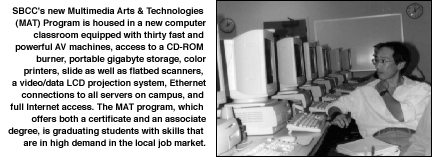
Copyright 1996 CAUSE. From CAUSE/EFFECT Volume 19, Number 4,
Winter 1996, pp. 30-33. Permission to copy or disseminate all
or part of this material is granted provided that the copies
are not made or distributed for commercial advantage, the
CAUSE copyright and its date appear, and notice is given that
copying is by permission of CAUSE, the association for
managing and using information resources in higher education.
To disseminate otherwise, or to republish, requires written
permission. For further information, contact Julia Rudy at
CAUSE, 4840 Pearl East Circle, Suite 302E, Boulder, CO 80301
USA; 303-939-0308; e-mail: [email protected]

SBCC offers associate degrees in arts and sciences, as well as occupational/technological training and business programs. The College is known for its success in transferring well-prepared students to the University of California, California State Universities, in-state independent colleges, and out-of-state four-year colleges and universities.
As part of the current planning process, the Council met with an outside facilitator to examine external trends and factors, identifying many technological implications in the process. The resulting plan is not just visionary and strategic; measurable outcomes with timelines are included. Among the specific goals of the 1996-99 plan are many technology-related directions:
Project Redesign (See Sidebar) was prompted by SBCC's realization of the need to make fundamental changes in institutional core processes, especially to more effectively use information technology to enable those changes. The processes being addressed are not just administrative in nature, but those that underlie the primary mission of the institution -- teaching and learning.
Project Redesign is providing the blueprint for technology acquisition and implemention at SBCC, ensuring the application of technology "in context," rather than for its own sake. At the same time, a great deal of technological infrastructure has been laid in the past three years, with a major investment in fully networking the College -- viewed as fundamental to changing College processes. In addition, the College demonstrated its belief that information resources, like human and financial resources, need cabinet-level leadership, by creating an associate vice presidential position to ensure effective College-wide planning and administration in this area.
Until recently, the process for planning for, acquiring, and funding technology was based on the independent development of technology plans by each vice president for his or her area in parallel with the IR division's development of an Information Technology Visions and Directions Statement. A number of weaknesses in this process were identified by a Project Redesign team who recommended an entirely new technology planning process, one that is centralized and more cross-functional in its approach, based on a number of planning principles articulated in the redesign team report.
A major outcome of this work was the establishment of a District Technology Council (DTC), to be responsible for institutional technology planning through integrating multiple unit plans for technology into institutional directions, for policy development, and for resource allocation. The DTC is chaired by Hamre, with a membership made up of vice presidents, faculty and classified staff representatives, the chair of the Instructional Technology Committee, and the Director of Educational Technology. The IR division is responsible for bringing standards and directions to the DTC and for technology infrastructure planning.
While Director of Educational Technology Support George Gregg provides support from within the IR division, planning and coordination for faculty use of instructional technology lies with Vice President for Academic Affairs Jack Friedlander. Recently Friedlander recognized that more and more of what SBCC is planning with respect to instructional technology cuts across specific academic programs, creating a need for cross-discipline academic affairs administration. Dean of Academic Affairs Susan Sargent has been charged with responsibilities in this area, overseeing projects that will have a College-wide impact. She also oversees several units that contribute to and support SBCC's vision for redesigning teaching and learning -- including the Faculty Resource Center, the Library, and Learning Support Services.
In the past year, Friedlander worked jointly with SBCC's Instructional Technology Committee to develop the Academic Affairs Instructional Technology Three-Year Plan. The purpose of this plan is to articulate strategies that promote student learning in an effective, flexible, and efficient manner through the effective use of technology. The plan sets forth eight goals to be achieved, lists eight criteria for instructional-technology-related projects to be approved, and identifies ten issues that must be resolved for the College to capitalize on the ability of technology to increase student involvement and learning. Hamre's division will work toward resolving the issues and implementing infrastructure solutions.
With the infrastructure in place, support issues have become paramount. The Information Resources division is currently providing support for information systems implementation and educational technology, as well as user and network support and media services. Hamre has realized in the brief life of the division how important it is to remain a flexible organization that can easily realign and redirect resources in response to emerging needs: "In the three years we've been a division, we've recast the organization as many times. Our greatest challenge has been and will continue to be, first, how to retrain, reallocate, and redeploy staff within the organization to support the great demand for information technology resources, and second, deciding what pieces of that support to outsource or co-source. The latter is really a key issue for us, as we simply do not have the capability of adding staff for everything the College wants to do."


Along these lines, the College has chosen to employ the services of consultants, especially for Project Redesign, and half-way through the project realized the need to create a full-time but temporary (two-year) position -- Director of Information Systems Development -- to oversee the implementation of redesign recommendations that require new systems acquisition or development. Three options are being considered: purchasing systems products, developing systems in-house, or co-sourcing to an industry partner. A Request for Information from Prospective Strategic Partners has resulted in Hewlett-Packard being selected as the general partner for Project Redesign. Negotiations are still under way for communications and courseware development partners.
To provide additional instructional support, the College established a Faculty Resource Center under the direction of Mark Ferrer, an English instructor who was given a three-year full-time assignment to serve in this position. According to Ferrer, the Center was established in response to the College's strong faculty development emphasis and goal to involve 60 percent of contract faculty in one or more professional development activities. The Center has two major objectives: (1) assist faculty in selecting and evaluating instructional technologies-related equipment and software, and (2) keep staff informed about new developments in learning technologies. Currently a major emphasis is on the World Wide Web to help faculty make presentations that will change the way they teach. Ferrer says faculty response has been overwhelming, with faculty far more willing and open to change than anticipated.
The Library also provides strong support for electronic information resources. Library systems are fully automated through the VTLS system, which is available by dial-in access. Plans include linking from VTLS workstations to the public catalogs of the University of California Santa Barbara and local public library system. CD-ROM collections are being built and the OCLC FirstSearch System (via the Internet) is used for periodical indexing.
One outcome of the close cooperation that exists between the IR division, Library, and FRC was the development of an "information literacy" course to be incorporated into a basic, required English course. The Library has also developed Web pages to help students learn to use the library, and works closely with the FRC in training faculty to use the Internet.

SBCC's vision for student services is to move toward a more student-centered approach to delivering information and support services from the time of the initial contact with the College through the student's period of enrollment and transfer and/or career transition. Technology is seen as key to improving numerous processes that affect student success.
Several Project Redesign teams have addressed such student-related processes, including registration, financial aid, and student access to information. The registration redesign process team has recommended that students be able to register on a "7x24" basis -- seven days a week, twenty-four hours a day, anytime, anywhere. New processes recommended by the financial aid team center on the acquisition of document imaging technology that will enable the College to more efficiently store financial aid documents and a variety of other information.
According to Dean of Student Development Keith McLellan, who led the redesign team that addressed access to student information, the team articulated the basic principle that students must have access to their data, and that such access should be provided in multiple ways -- through kiosks, workstations in labs, the Internet/World Wide Web, and/or voice response technology.
A key driving force for the recommendations of these teams was the belief that students' most valuable possession is time; thus administrative processes need to be streamlined so that students can spend less time mired in bureaucray and more time focusing on educational pursuits.
According to Director of Information Systems Development George Beahan, SBCC's technology strategies for administrative systems are based on converting current administrative legacy systems to a client/server environment. The first pilot will address student information access, implementing the recommendations of the redesign teams by providing a user-friendly graphic interface and independent access to student information.
This year, SBCC was gratified to have been provided an opportunity by the Accrediting Commission for Community and Junior Colleges to do its self-study for accreditation in a unique way. The College requested and was granted permission to focus on Project Redesign and use the accreditation standards as a means to view how redesign activities were affecting the College. The resulting Institutional Self-Study for Reaffirmation of Accreditation demonstrates SBCC's continued commitment to innovation and continuous improvement, and to the effective use of technology to achieve these ends.
 The greatest challenge that higher education is facing is
technologically induced, but the greatest capacity we have to
respond to that challenge is going to be enabled by
technology. Technology is both the source of the problem and
the source of the solution.
The greatest challenge that higher education is facing is
technologically induced, but the greatest capacity we have to
respond to that challenge is going to be enabled by
technology. Technology is both the source of the problem and
the source of the solution.
That great challenge is competition. Until recently, we really have not had much competition in higher education except from each other. But competition in the future will be from private entities that will be providing high-quality degrees for people in alternative ways. Some of that will be from traditional sources -- I can see institutions such as Stanford providing degree opportunities over the Internet and perhaps in other forms that will compete with other undergraduate institutions. Other competition will emerge from private industry sources such as Motorola University, Jones Network and Cabling System, and other delivery systems that will continue to be refined to offer highly variable and high-quality options over a period of time.
So we are going to have to be much more customer oriented and much more effective in delivering what we deliver. And we are going to have to look for niches in how we serve our communities more effectively. I see technology as being an enabler for us to be able to craft a much more responsive and diversified structure than we have in the past.
The modal instructional delivery mechanism has been pretty much the same -- we create a campus with facilities and classrooms, and students come at selected periods of time, mostly between Monday and Friday, to attend classes that translate into a degree. If we continue to rely on that modality in the future as our sole means of providing what we provide, we're not going to be as effective as we need to be. In California, much more so than other states, what we call Tidal Wave II -- half a million additional students expected in the higher education system over the next several years -- is going to require colleges and universities to respond in much more economical ways to delivering higher education. Either we are going to be a part of that solution or we are going to deny access to people. We have to look at how we provide that access at a per-student cost that is less than what we have at present. Demand for education and need to provide access are two key variables, and our ability to respond will be enabled by technology -- it will provide the more diverse mechanisms needed to compete in the future.
From an interview with Peter MacDougall, September 1996
 Two years ago, Santa Barbara City College was involved in the
process of cutting half a million dollars from its budget in
response to state funding cutbacks. Realizing that the
College was "cannibalizing" what it represented, the College
Planning Council decided to rethink and restructure the core
processes of the College, using business process
reengineering principles and continuous quality improvement
methodologies, to "significantly increase institutional
effectiveness by evaluating and dramatically changing the
College's means of delivering its instructional and student
support services programs, as well as its administrative
support processes."
Two years ago, Santa Barbara City College was involved in the
process of cutting half a million dollars from its budget in
response to state funding cutbacks. Realizing that the
College was "cannibalizing" what it represented, the College
Planning Council decided to rethink and restructure the core
processes of the College, using business process
reengineering principles and continuous quality improvement
methodologies, to "significantly increase institutional
effectiveness by evaluating and dramatically changing the
College's means of delivering its instructional and student
support services programs, as well as its administrative
support processes."
Leadership for the project is provided by SBCC President Peter MacDougall and the College Planning Council, which functions as the Steering Committee. To ensure full participation by faculty, an instructional redesign team was created, under the leadership of Vice President for Academic Affairs Jack Friedlander and Academic Senate leaders. Friedlander distributed a paper to faculty during an in-service day to explain the redesign project and invite proposals for potential instructional redesign.
More than 100 processes were identified overall, twenty of which were selected for redesign in the first phase of the project, including student access to information, financial aid, assessment/advisement of students, registration, schedule development, computer allocation, purchasing, computer training, and six instructional projects selected from faculty proposals.
A management team appointed to guide the project includes MacDougall, Hamre, Director of Information Systems Development George Beahan, and two other key individuals -- Janice Peterson, a faculty leader responsible for all of the training components of the project, and George Tamas, a consultant on technology and change initiatives responsible for developing corporate partnerships. A communications committee was appointed to promote understanding of the project and provide ongoing two-way communication with the College community.
During the first year, the Council developed charges and trained a team for each process to be redesigned. These teams, which consisted of eight to ten people from cross-functional areas led by the "owner" of the process, dedicated 75 percent of their time for two to four weeks to redesign their process. By the fall of 1996, most teams had completed their work and made recommendations, many of which have been or are being implemented. In the final evaluation, SBCC will determine if team goals were achieved from two standpoints: enabling greater effectiveness and effecting cost savings or significant increase in efficiencies.
According to Friedlander, while results to date of the instructional redesign component have been excellent, they have nonetheless been discipline/department specific; no major breakthroughs have occurred at a College-wide level. In the next phase of the project, an Instructional Innovation Committee under Friedlander's leadership will begin bringing people from different parts of the College together to look at the whole issue of student learning from an institution-wide perspective -- for example, to look at such things as how SBCC will do distance learning and how faculty will spend their time in a redesigned environment.
This article is based on a visit to the Santa Barbara City College by editor Julia Rudy. CAUSE/EFFECT's Campus Profile department regularly focuses on the information resources environment -- information, technology, and services -- of a CAUSE member institution, to promote a better understanding of how information resources are organized, managed, planned for, and used in colleges and universities of various sizes and types.